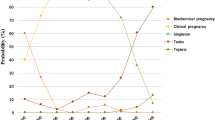Summary
This paper was aimed to study the minimum dose of human chorionic gonadotropin (hCG) to effectively trigger maturation of oocytes and prevent ovarian hyperstimulation syndrome (OHSS) in a series of hyper-responders treated with a long gonadotropin releasing hormone agonist (GnRHa) protocol. Six women at high risk of developing severe OHSS in a long GnRHa protocol were enrolled into this study. Serum hormone levels on the day of and after hCG administration, antral follicle count, oocyte retrieval number and quality were determined. In total, 6 women aged between 29 and 36 years and at risk of developing severe OHSS, received 2000 U hCG. Five of them were treated with coasting for 1 day and the rest one for 4 days. The mean number of oocytes collected was 19 (range 14–27) and the fertilization rate per collected oocyte was 72.81%. Of the 6 women in the study, only one cancelled embryos transfer and all embryos were frozen, and then she delivered two health boys on term in the subsequent frozen-thawed embryo transfer (FET) cycle. Pregnancies and births were achieved in 3 patients out of 5 in vitro fertilization-embryo transfer (IVF-ET) cycles. No woman developed moderate or severe OHSS. Triggering with 2000 U hCG is feasible to prevent OHSS in unpredicted hyper-responders undergoing IVF in a long GnRHa protocol.
Similar content being viewed by others
References
Humaidan P, Quartarolo J, Papanikolaou EG. Preventing ovarian hyperstimulation syndrome: guidance for the clinician. Fertil Steril, 2010,94(2):389–400
Forman RG, Frydman R, Egan D, et al. Severe ovarian hyperstimulation syndrome using agonist of gonadotropin-releasing hormone for in vitro fertilization: a European series and a proposal for prevention. Fertil Steril, 1990,53(3):502–509
Garcia-Velasco JA, Isaza V, Quea G, et al. Coasting for the prevention of ovarian hyperstimulation syndrome: much ado about nothing? Fertil Steril, 2006,85(3): 547–554
Abdalla HI, Ah-Moye M, Brinsden P, et al. The effect of the dose of human chorionic gonadotropin and the type of gonadotropin stimulation on oocyte recovery rates in an in vitro fertilization program. Fertil Steril, 1987,48(6): 958–963
Nargund G, Hutchison L, Scaramuzzi R, et al. Low-dose HCG is useful in preventing OHSS in high-risk women without adversely affecting the outcome of IVF cycles. Reprod Biomed Online, 2007,14(6):682–685
Spitzer D, Wogatzky J, Murtinger M, et al. Dopamine agonist bromocriptine for the prevention of ovarian hyperstimulation syndrome. Fertil Steril, 2011,95(8):2742–4.e1
Youssef MAFM, Al-Inany HG, Evers JLH, et al. Intravenous fluids for preventing severe ovarian hyperstimulation syndrome. Cochrane Database Syst Rev, 2011,(2):CD001302
Villasante A, Pacheco A, Ruiz A, et al. Vascular endothelial cadherin regulates vascular permeability: implications for ovarian hyperstimulation syndrome. J Clin Endocrinol Metab, 2007,92(1):314–321
Ludwig M, Doody KJ, Doody KM. Use of recombinant human chorionic gonadotropin in ovulation induction. Fertil Steril, 2003,79(5):1051–1059
Schmidt DW, Maier DB, Nulsen JC, et al. Reducing the dose of human chorionic gonadotropin in high responders does not affect the outcomes of in vitro fertilization. Fertil Steril, 2004,82(4):841–846
Ulug U, Bahceci M, Erden HF, et al. The significance of coasting duration during ovarian stimulation for conception in assisted fertilization cycles. Hum Reprod, 2002,17(2):310–313
Moon HS, Joo BS, Moon SE, et al. Short coasting of 1 or 2 days by withholding both gonadotropin and gonadotropin-releasing hormone agonist prevents ovarian hyperstimulation syndrome without compromising the outcome. Fertil Steril, 2008,90(6):2172
Yilmaz N, Uygur D, Ozgu E, et al. Does coasting, a procedure to avoid ovarian hyperstimulation syndrome, affect assisted reproduction cycle outcome? Fertil Steril, 2010,94(1):189–193
Author information
Authors and Affiliations
Corresponding author
Rights and permissions
About this article
Cite this article
Chen, X., Chen, Sl., He, Yx. et al. Minimum dose of hCG to trigger final oocyte maturation and prevent OHSS in a long GnRHa protocol. J. Huazhong Univ. Sci. Technol. [Med. Sci.] 33, 133–136 (2013). https://doi.org/10.1007/s11596-013-1085-z
Received:
Published:
Issue Date:
DOI: https://doi.org/10.1007/s11596-013-1085-z




